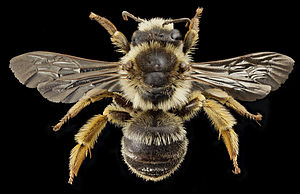Sägehornbienen
| Sägehornbienen | ||||||||||||
|---|---|---|---|---|---|---|---|---|---|---|---|---|
 Glockenblumen-Sägehornbiene Melitta haemorrhoidalis | ||||||||||||
| Systematik | ||||||||||||
| ||||||||||||
| Wissenschaftlicher Name | ||||||||||||
| Melitta | ||||||||||||
| Kirby, 1802 |
Die Sägehornbienen (Melitta) sind eine Gattung von Bienen aus der Familie der Melittidae mit 47[1][2] bekannten Arten.
Verbreitung
Die Gattung ist in der Paläarktis, Nearktis sowie in Süd- und Ostafrika verbreitet. Am meisten Arten findet man in der Paläarktis. Es gibt fünf Zentren der Artenvielfalt: Mittelmeerraum (mit Spanien, Türkei und Maghreb), Himalaya, China (vor allem südliche und nördliche Gebiete), Nordamerika (Kalifornien und Ostküste) und südliches Afrika.[2]
Merkmale
Sägehornbienen sind ca. 10 bis 14 mm groß, dunkel gefärbt, mit hellen Haarbinden an den Hinterleibstergiten, die schmal oder auch breit sein können. In beiden Geschlechtern können sie mit Andrena Arten verwechselt werden,[3] es fehlt ihnen jedoch die für Andrena typische Haarlocke (Flocculus) an der Basis des Hinterbeines (Trochanter).
Die Fühlerglieder der Männchen haben charakteristische, manchmal nur schwer erkennbare Verdickungen. Diese „Sägestruktur“ ist der Grund für den deutschen Namen.
Lebensweise
Die Biologie ist vor allem von den europäischen Arten bekannt.[2] Bei den Sägehornbienen schlüpfen die Männchen ca. drei Wochen vor den Weibchen (proteransdrisch) im Juni und schwärmen auf festen Flugbahnen zwischen den Trachtpflanzen auf der Suche nach Weibchen. Die Männchen bilden oft Schlafgemeinschaften an Stängeln oder in Blüten.[4]
Die Weibchen leben solitär, sie graben Nester in den Boden, der oft dicht bewachsen sein kann.[3] Die meisten Arten sind oligolektisch, d. h. sie sammeln nur Pollen bestimmter Pflanzen.
Systematik
Die Gattung wird in zwei Untergattungen eingeteilt. Die Untergattung Melitta (s. str.) enthält 7 Arten, ist auf die Paläarktis beschränkt und enthält die in Europa vorkommenden Arten M. tricincta, M. leporina und M. nigricans. Die Untergattung Cilissa enthält die anderen 40 Arten und ist in der Paläarktis, Nearktis und Afrotropis verbreitet. In diese Untergattung gehören die andren mitteleuropäischen Arten (siehe unten).[1][2]
Mitteleuropäische Arten
Nach [3], jeweils Vorkommen in Deutschland (D), Österreich (A), Schweiz (CH), deutsche Namen nach[5].
- Esparsetten-Sägehornbiene Melitta dimidiata (A, D, CH)
- Glockenblumen-Sägehornbiene Melitta haemorrhoidalis (A, D, CH)
- Luzerne-Sägehornbiene Melitta leporina (A, D, CH)
- Melitta melanura (D[5])
- Blutweiderich Sägehornbiene Melitta nigricans (A, D, CH)
- Zahntrost-Sägehornbiene Melitta tricincta (A, D, CH)
Literatur
- Paul Westrich, 2018. Die Wildbienen Deutschlands. Eugen Ulmer Verlag, Stuttgart. 827 S. (hier S. 138ff, 566f); ISBN 978-3-8186-0123-2.
- A. Müller, A. Krebs, F. Amiet 1997. Bienen. Mitteleuropäische Gattungen, Lebensweise, Beobachtung. Natur Buch Verl. ISBN 3-89440-241-5.
Weblinks
Einzelnachweise
- ↑ a b D. Michez & C. Eardley: Monographic revision of the bee genus Melitta Kirby 1802 (Hymenoptera: Apoidea: Melittidae). In: Ann. soc. entomol. Fr. (n.s.). Band 43, Nr. 4, 2007, S. 379–440 (atlashymenoptera.net [PDF]).
- ↑ a b c d D. Michez, M. Kuhlmann, S. P. Ivanov & V. G. Radchenko: Description of four new species in the bee genus Melitta Kirby, 1802 (Hymenoptera: Melittidae). In: Zootaxa. Band 3337, 2012, S. 57–67 (atlashymenoptera.net [PDF]).
- ↑ a b c Müller, Andreas., Krebs, Albert., Amiet, Felix.: Bienen: mitteleuropäische Gattungen, Lebensweise, Beobachtung. Natur-Buch-Verl, Augsburg 1997, ISBN 3-89440-241-5, S. 384.
- ↑ Solitärbienen-Arten: Sägehornbienen (Melitta). Abgerufen am 29. April 2019.
- ↑ a b P. Westrich: Die Wildbienen Deutschlands. 2018, S. 827.
Auf dieser Seite verwendete Medien
Autor/Urheber: (of code) -xfi-, Lizenz: CC BY-SA 3.0
The Wikispecies logo created by Zephram Stark based on a concept design by Jeremykemp.
Melitta haemorrhoidalis, Red-butted Campanula Lover, specimen collected by R.C.L. Perkins in Wotton-under-Edge, England
Melitta is the Greek word for bee, and the name of the favorite activity indulged in by the authors – melittology – is based upon this. Melitta bees are specialists. All bees have some preferences for which sorts of pollen they like to gather for their young, some though, like Melitta, take it to the extreme. All the Melitta species that are well known appear to restrict their pollen gathering activities to single species or small groups of closely related species of plants. Thus in North America, there are Mellita that specialize on members of the Heather family, specifically Cranberry, Deerberry, and Maleberry, while elsewhere in the world preferences differ.
Our friend the Red-butted Campanula Lover pictured here is the most common of the Melitta species in Europe. As the name implies, it requires patches of Bellflowers to create a successful nest and thus its range overlaps that of these plants. If one looks closely you will see a patch of orangish hairs at the very tail end of the abdomen and you will then know how it got its scientific name and the common name we subsequently gave it.
17:01, 17 November 2014 (UTC)17:01, 17 November 2014 (UTC){{{{{{0}}}}}}17:01, 17 November 2014 (UTC)17:01, 17 November 2014 (UTC)
All photographs are public domain, feel free to download and use as you wish.
Photography Information: Canon Mark II 5D, Zerene Stacker, Stackshot Sled, 65mm Canon MP-E 1-5X macro lens, Twin Macro Flash in Styrofoam Cooler, F5.0, ISO 100, Shutter Speed 200
Further in Summer than the Birds
Pathetic from the Grass
A minor Nation celebrates
Its unobtrusive Mass.
No Ordinance be seen
So gradual the Grace
A pensive Custom it becomes
Enlarging Loneliness.
Antiquest felt at Noon
When August burning low
Arise this spectral Canticle
Repose to typify
Remit as yet no Grace
No Furrow on the Glow
Yet a Druidic Difference
Enhances Nature now
-- Emily Dickinson
Want some Useful Links to the Techniques We Use? Well now here you go Citizen:
Basic USGSBIML set up: www.youtube.com/watch?v=S-_yvIsucOY
USGSBIML Photoshopping Technique: Note that we now have added using the burn tool at 50% opacity set to shadows to clean up the halos that bleed into the black background from "hot" color sections of the picture.
www.youtube.com/watch?v=Bdmx_8zqvN4
PDF of Basic USGSBIML Photography Set Up:
ftp://ftpext.usgs.gov/pub/er/md/laurel/Droege/How%20to%20Take%20MacroPhotographs%20of%20Insects%20BIML%20Lab2.pdf
Google Hangout Demonstration of Techniques:
plus.google.com/events/c5569losvskrv2nu606ltof8odo
or
www.youtube.com/watch?v=4c15neFttoU
Excellent Technical Form on Stacking:
www.photomacrography.net/
Contact information: Sam Droege sdroege@usgs.gov
301 497 5840
